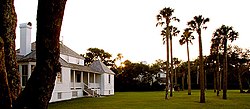Kingsley Plantation | |
 | |
| Location | within the Timucuan Ecological and Historic Preserve, Jacksonville, Florida |
|---|---|
| Nearest city | Jacksonville, Florida, U.S. |
| Coordinates | 30°26′18″N 81°26′17″W / 30.43833°N 81.43806°W |
| Area | 60 acres (24.3 ha) |
| Built | 1797 or 1798 |
| NRHP reference No. | 70000182[1] |
| Added to NRHP | September 29, 1970 |
Kingsley Plantation (also known as the Zephaniah Kingsley Plantation Home and Buildings) is the site of a former estate on Fort George Island, in Duval County, Florida, that was named for its developer and most famous owner, Zephaniah Kingsley, who spent 25 years there. It is located at the northern tip of Fort George Island at Fort George Inlet, and is part of the Timucuan Ecological and Historic Preserve managed by the U.S. National Park Service. Kingsley's house is the oldest plantation house still standing in Florida, and the solidly-built village of slave cabins is one of the best preserved in the United States. It is also "the oldest surviving antebellum Spanish Colonial plantation in the United States."[2]
The plantation originally occupied the entirety of Fort George Island, described variously as occupying 713, 720, or "750 acres [300 ha] more or less".[3] According to park literature, most of it has been taken back over by forest; the structures and grounds of the park now comprise approximately 60 acres (24 ha).[4] Evidence of pre-Columbian Timucua life is on the island, as are the remains of a Spanish mission named San Juan del Puerto. Under British rule in 1765, a plantation was established that cycled through several owners while Florida was transferred back to Spain and then the United States. The longest span of ownership was under Kingsley and his family, a polygamous and multiracial household controlled by and resistant to the issues of race and slavery.
The principal business at the Kingsley Plantation was slaves: buying, selling, and training them. Kingsley's slaves commanded a premium in the market. Raising salable cotton was a secondary business. As they were very isolated they also had to raise their food, in small gardens. By the standards of the day Kingsley treated his slaves well—he married one—and they were loyal to him.
Free blacks and several private owners lived at the plantation until it was purchased by the State of Florida in 1955. It was acquired by the National Park Service in 1991.
The most prominent features of Kingsley Plantation are the owner's house—a structure of architectural significance built probably between 1797 and 1798 that is cited as being the oldest surviving plantation house in the state[5][6]—and an attached kitchen house, barn, and remains of 25 anthropologically valuable slave cabins that endured beyond the U.S. Civil War (1861–1865). The foundations of the house, kitchen, barn, and the slave quarters were constructed of durable tabby concrete. Archeological evidence found in and around the slave cabins has given researchers insight into African traditions among slaves who had recently arrived in North America.
Zephaniah Kingsley wrote a defense of slavery and the three-tier social system that acknowledged the rights of free people of color that existed in Florida under Spanish rule. Kingsley briefly served on the Florida Territorial Council.
Kingsley Plantation was not Kingsley's only or even his primary plantation. His plantation on Drayton Island has not been studied. "At the other end of Fort George, now Batten Island, he built himself a house of some size, which is now [1878] in ruins; there lived Flora, his black mistress. He divided his time about equally between the two places."[7]: 845 "In the 1830 census he owned only 39 slaves at the present Fort George site, but 188 at a little-known San José plantation, in Nassau County.[3]: 69 In 1836 he moved his entire family from Florida, since Kingsley's free Blacks were ever more unwelcome and insecure, to a plantation called Mayorasgo de Koka, at the time in Haiti but from the 1840s in the Dominican Republic. Little remains of Mayorasgo de Koka.[8]
- ^ "National Register Information System". National Register of Historic Places. National Park Service. March 13, 2009.
- ^ Marshall, Amani T. (2022), The Enslaved Communities on Fort George Island. A Special History Study for Timucuan Ecological & Historic Preserve (PDF), National Park Service, archived (PDF) from the original on December 27, 2022
- ^ a b Walker, Karen Jo (1988). Kingsley and his slaves : anthropological interpretation and evaluation. Columbia, South Carolina: South Carolina Institute of Archaeology and Anthropology, University of South Carolina. p. 7.
- ^ Carter, John (October 20, 2004). "Slave history event at Kingsley site: Plantation having 'a sort of family reunion'." Florida Times-Union (Jacksonville), p. N-1.
- ^ "Archaeology Field School". Timucuan Ecological and Historic Preserve, National Park Service. Retrieved 15 May 2010.
- ^ Brown, Alan (2002). Haunted places in the American South. Jackson, Mississippi: University Press of Mississippi. p. 59. ISBN 1578064767.
- ^ "The Sea Islands". Harper's New Monthly Magazine. 57: 839–861. 1878.
- ^ Schafer, Daniel L. (2003). Anna Madgigine Jai Kingsley: African princess, Florida slave, plantation slaveowner. Gainesville : University Press of Florida. pp. 67–69. ISBN 978-0-8130-2616-9.

